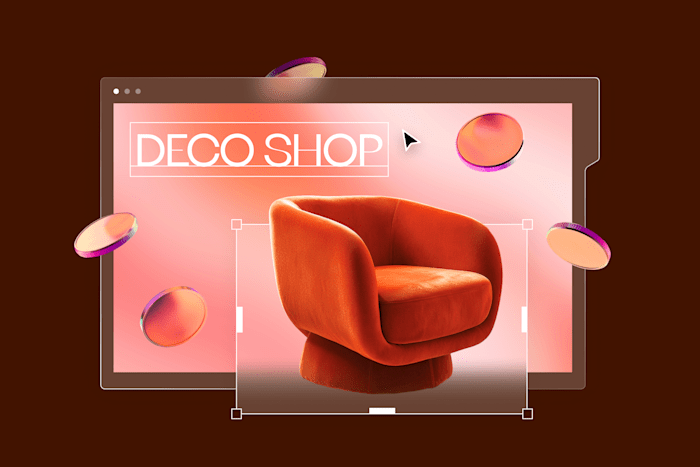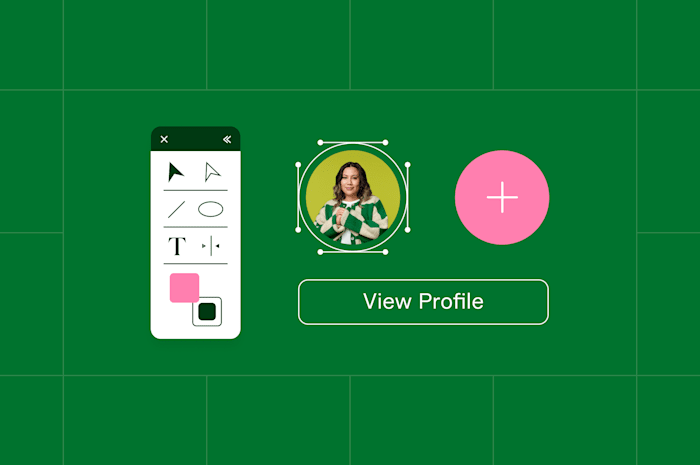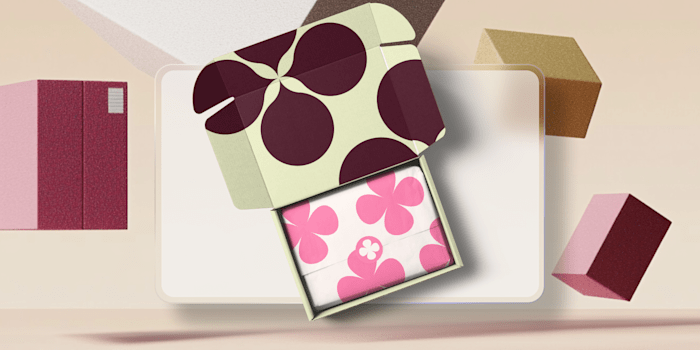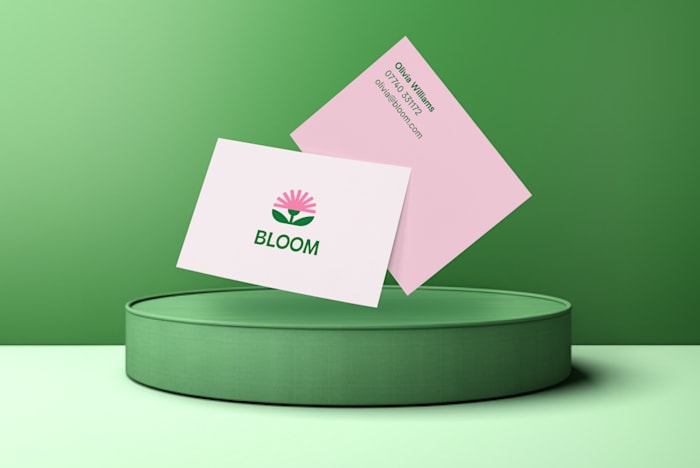The Top 10 Figma Alternatives for 2025
Whether it's real-time collaboration, advanced prototyping, or budget-friendly options, there's a Figma alternative for you.
 February 18, 2025
February 18, 2025 12 minute reading
12 minute reading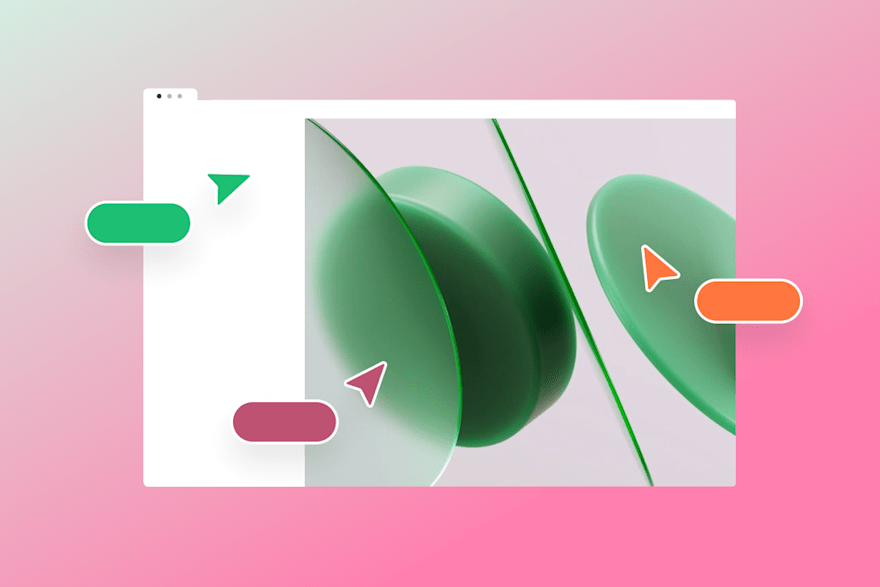
You only have about 50 milliseconds to make an impression online. And your design, visuals, and site usability are the first elements that attract customer interest.
There’s a lot to get right on your website to capture attention in the blink of an eye. But don’t get overwhelmed. UI and UX designers know that the first step to good user design and graphic design is choosing the right design tool.
Below is a breakdown of what to consider when choosing your design software and the best alternatives (with pros and cons) to the most popular design software on the market today.
What is Figma and how does it work?
Figma is considered one of the most popular design tools today. According to a survey by Contrary Research, as of 2024, Figma has over four million users, and 75% of product designers in 2023 used Figma as the primary choice for UI design.
Figma set itself apart by creating a cloud-based platform so that design teams could collaborate in real time. Think of it as Google Docs for designers. Team members can simultaneously work on the same design file, making changes and leaving feedback. That means you don’t need to download or transfer files and can work from any device without installing software.
Figma's comprehensive list of tools and collaborative-focused approach has been especially attractive to large companies like HelloFresh, Volkswagen, and even Google.
Features to look for in a Figma alternative
Figma is a great design tool, but it’s not the only option out there, and it might not be a good fit for you. For example, some things that make it great for large corporations can bog down a small business. If you’re working on a budget, it makes no sense to pay for features you’ll never use. Or maybe you’re a veteran designer, and you need more advanced features.
Thankfully, there are plenty of alternatives to Figma. To help you simplify your search, here are a few key things to look out for before choosing your design tool:
Component library & design systems: A component library stores reusable design elements (like buttons, forms, and navigation menus). The design system gives guidelines for how to use these stored components (like color palette and font design). Look for tools to create, manage, and update reusable components across projects.
Real-time collaboration: If you plan to collaborate or get feedback on any design elements of your site, real-time collaboration is a feature you’ll want. Tools that allow simultaneous editing, commenting, and feedback will save you time and headaches.
Prototyping capabilities: Before bringing your designs to life, you need to test if they’ll work. Look for features that help you test ideas quickly and gather feedback with features like user simulation flows and clickable prototypes.
Developer handoff tools: It’s common for there to be snags when trying to figure out how to make your creative ideas work on the backend. Good developer handoff features like asset export, auto code generation, and detailed specs will help translate and smooth out the designer-to-developer process.
Vector editing: Vector editing capabilities ensure you can create and modify illustrations and icons without switching to another tool. Depending on the designs you want to make, look for features like pen tools, boolean operations, and shape editing.
Auto-layout: You shouldn’t have to adjust your design layout just because it’s being seen on a different screen size or device. Save yourself the headache and make sure your alternative tool automatically adjusts your designs.
Version history: Any good design tool should allow you to track any changes made to your designs and will enable you to revert to previous versions.
Asset export: Your designs need to work for various formats, resolutions, and different specs. Make sure the tool you choose has features that make exporting easy to save you time.
10 best Figma alternatives
1. Adobe XD

Adobe
Adobe XD is a design and prototyping tool that caters to everyone from product managers to graphic artists. It has all the capabilities of Figma for UI and UX designers but is mainly used offline and has limited collaboration functions built in.
The standout feature of this tool is its seamless integration with the Adobe Creative Cloud Suite. Designers can effortlessly move their work between Photoshop, Illustrator, and other Adobe programs, making it easier to manage complex projects.
Note: there are rumors that Adobe might be phasing out Adobe XD in the future.
Adobe best features:
Integration with Adobe Creative Suite
Repeat grid feature
Voice prototyping functionality
Offline working capability
Adobe limitations:
No real-time collaboration features
Regular desktop software updates are required
CSS export challenges without plugins
Prototype glitches with non Apple operating systems
Adobe might be phasing this program out
Adobe pricing:
Only available through Creative Cloud subscription ($54.99/month)
No longer offered as a standalone app ($9.99/month option discontinued)
Adobe ratings:
G2: 4.4/5
Capterra: 4.3/5
Look for a professional Graphic Designer on Fiverr
2. Penpot

Penpot
An open-source design platform launched in 2019 by Kaleidos, Penpot has grown to serve over 80,000 teams, including those at tech giants like Google and Microsoft. Completely free, but still packed with features, this web-based tool is an excellent option for businesses and designers that need to keep design costs down.
Penpot best features:
Open-source and self-hostable
Seamless designer-developer collaboration with code inspection
Unlimited teams and projects on the free tier
Custom fonts and flexible layouts
API for workflow integrations
Penpot limitations:
Browser-based only—capabilities dependent on internet connection
Fewer plugins compared to commercial alternatives
Limited advanced animation capabilities
The context menu can be overwhelming for beginners
Penpot pricing:
Free: Unlimited teams, designers, files, and libraries
Professional: Adds preferred hosting and premium support (custom quote)
Enterprise: Adds advanced security, SSO, custom hosting, and analytics (custom quote)
Penpot ratings:
G2: 4.7/5
Capterra: 4.8/5
3. UXPin

UXPin
Launched in 2010, UXPin, is a design platform that offers browser-based and desktop applications for Windows and macOS and a prototype "mirror" app for mobile devices. It enables the creation of wireframes, high-fidelity UI designs, and interactive mockups across multiple platforms.
This design tool is useful when dealing with complex designs requiring detailed prototyping. There’s a steep learning curve, but it offers many resources like tutorials, documents, and live chat to help combat that. UXPin is especially good at bridging the gap between design and development.
UXPin best features:
Advanced prototyping with conditional logic and variables
Real-time collaboration capabilities
Direct integration with React libraries (MUI, Ant-Design, Bootstrap)
Import compatibility with Figma and Sketch
AI-powered components (in higher tiers)
Integration with Git, Storybook, and font services
UXPin limitations:
Steep learning curve for new users
Sparse initial design window
Performance issues with complex projects
Basic templates are limited
UXPin pricing:
Free: Basic plan for interactive prototypes
Essentials: $6/user/month (annual) or $8/user/month (monthly)
Advanced: $29/user/month (annual) or $39/user/month (monthly)
Merge AI: $39/user/month (annual) or $49/user/month (monthly)
Company: $119/user/month (annual) or $149/user/month (monthly)
Enterprise: Custom pricing
UXPin ratings:
G2: 4.5/5
Capterra: 4.4/5
4. Lunacy
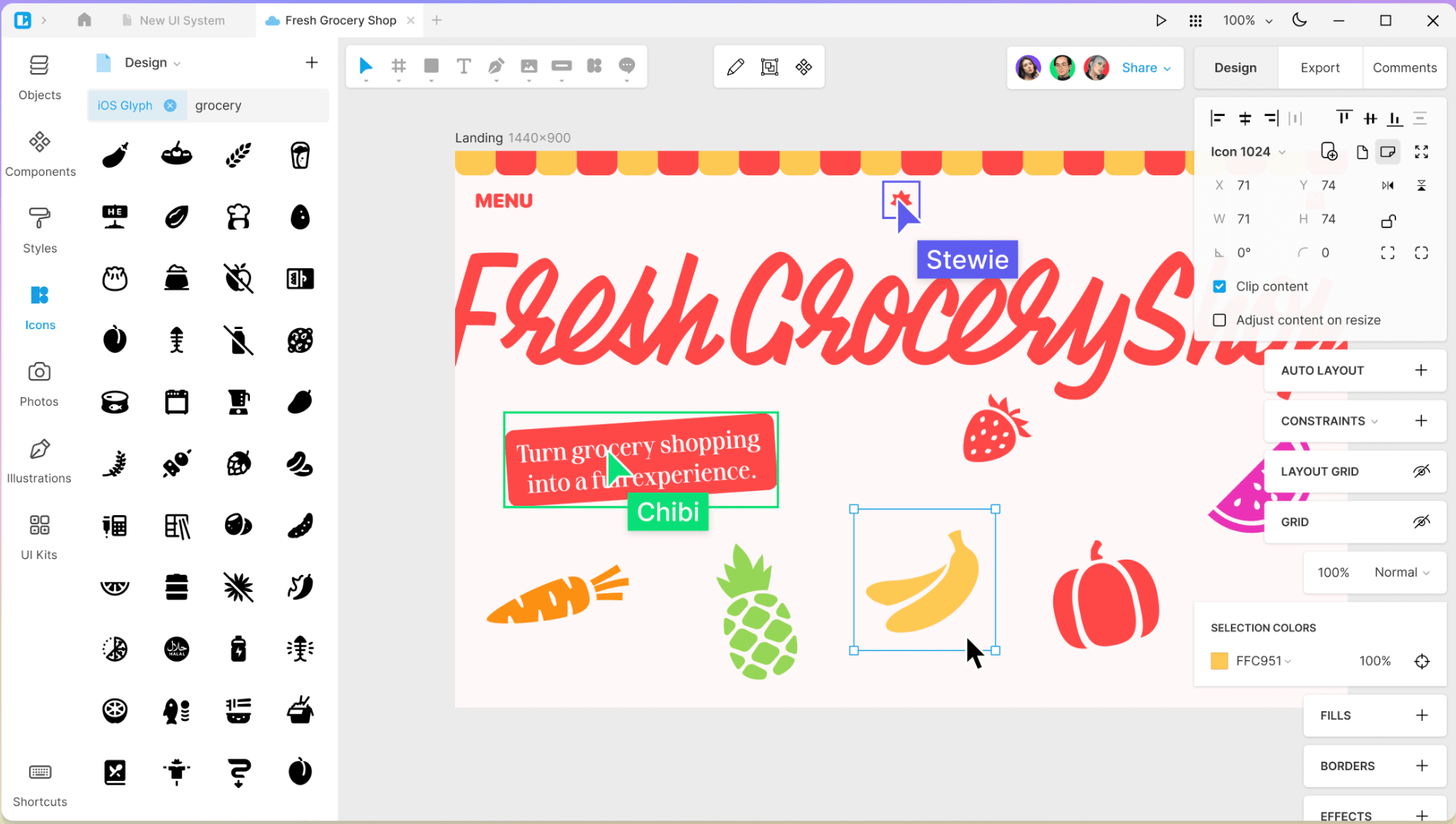
Lunacy
Developed by Icons8 LLC, Lunacy is a design application available for Windows, macOS, and Linux. As both an offline-capable tool and a cloud-based platform, it offers the best of both worlds of UX design. Lunacy’s features and capabilities are a great option for individual designers and small teams, especially those looking for more flexibility and affordability.
Lunacy best features:
Full offline functionality
Direct web page editing functionality
AI-powered design tools
Real-time collaboration
Design system support
Lunacy limitations:
Smaller community compared to major competitors
Limited compatible plugins
Fewer advanced prototyping features
Less extensive third-party integrations
Limited enterprise-level features
Lunacy pricing:
Free: Available with limited cloud documents
Personal Cloud Plan: $4.99/month
Professional Team: $4.99/user/month
Graphics Subscription: $9.99/month (additional)
Lunacy ratings:
G2: 4.6/5
Capterra: 4.5/5
5. Moqups
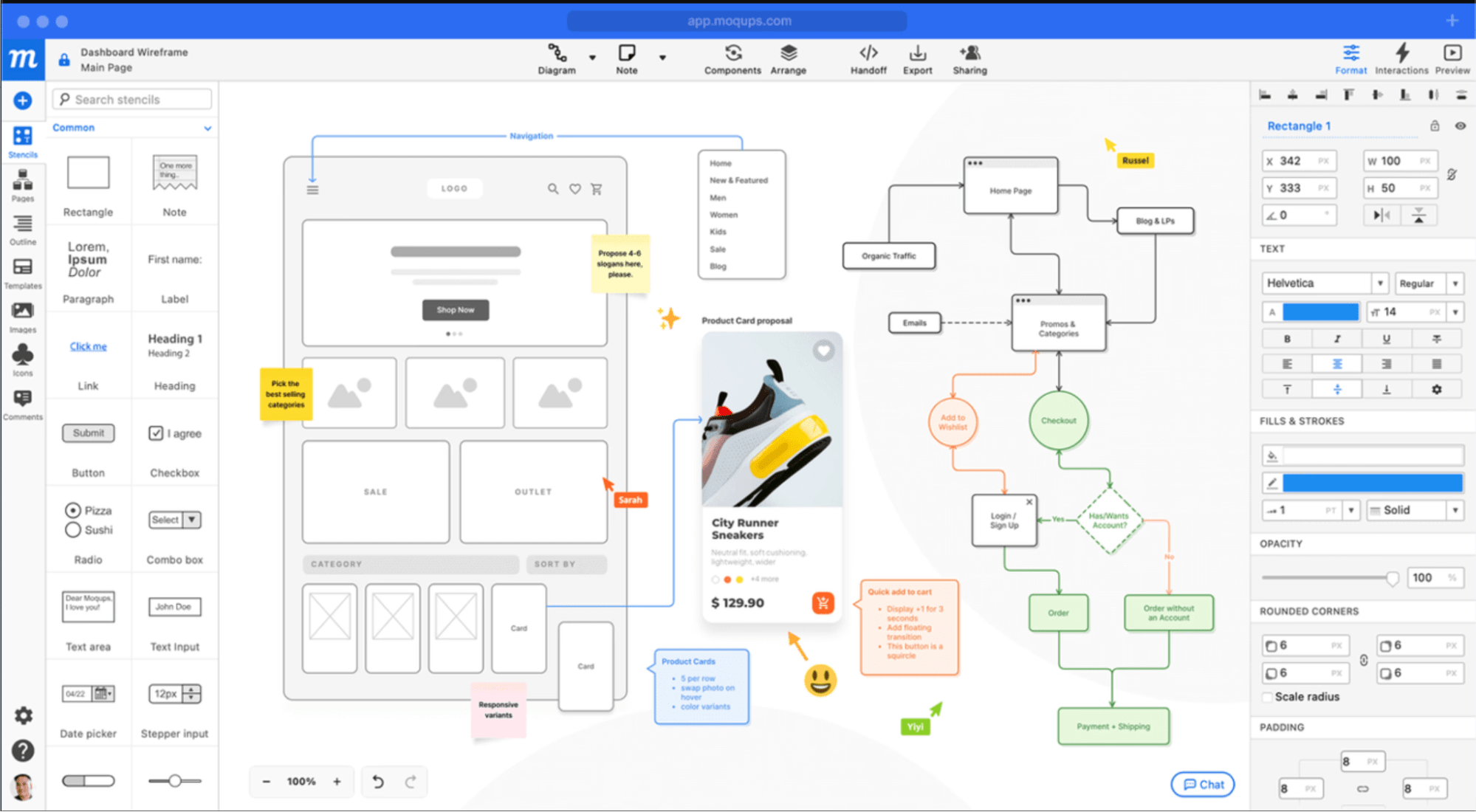
Moqups
Moqups is an all-in-one cloud-based platform that helps teams create and validate web and mobile application prototypes, wireframes, and mockups. Its whiteboarding capabilities and design tools make it great for use during the early stages of project planning.
This tool is handy for businesses that want to conceptualize and communicate design ideas quickly. Its extensive stencil library and intuitive drag-and-drop interface make it the perfect tool for non-developers who need to create professional-looking prototypes without much advanced technical know-how.
Moqups best features:
Real-time collaboration and feedback system
Master Pages functionality for consistent designs
Non-destructive image editing
Storyboard features
Drag-and-drop features which are good for making mood boards
Cloud-based workflow with offline capabilities
Integration with Slack, Google Drive, and Dropbox
Vectorial zooming without quality loss
Moqups limitations:
More focused on low to mid-fidelity prototyping
Limited advanced animation capabilities
Some features are restricted to higher-tier plans
The mobile interface is a bit limited
Fewer third-party integrations compared to competitors
Moqups pricing:
Free: Basic features available
Solo: $17/month (1 seat)
Team: $32/month (3 seats)
Unlimited: $89/month or $67/month billed annually
Moqups patings:
G2: 4.5/5
Capterra: 4.3/5
Find Expert Graphic Designers for Hire
6. Framer
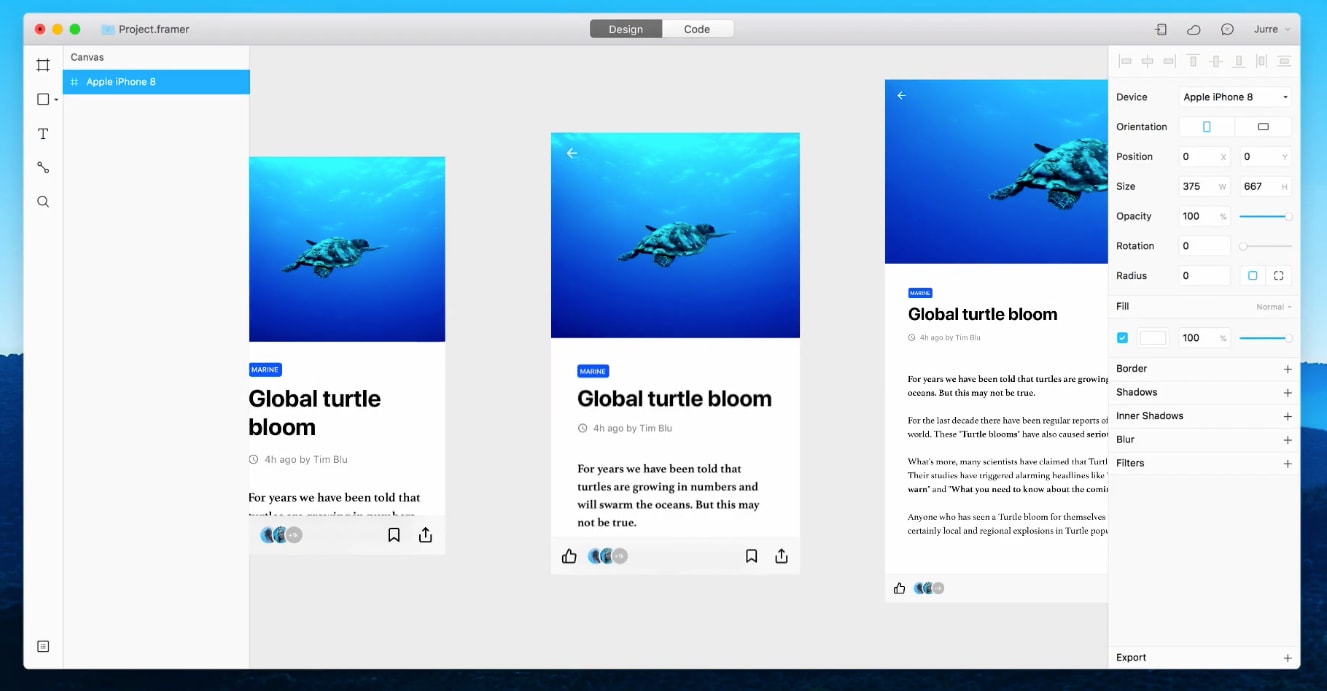
Framer
Based in Amsterdam, Framer is a design and prototyping platform that excels in creating high-fidelity interactive designs. It offers web-based and desktop applications for Windows and macOS, with a strong focus on animation and interactive capabilities.
Framer has more advanced interactive design capabilities and sophisticated prototyping tools, making it particularly suitable for teams creating complex, interactive digital products. The learning curve to use this tool is steep, but Framer does offer supportive resources.
Framer best features:
Real-time collaboration features
Built-in generative AI assistance
CMS integration for blog functionality
SEO tools
Staging environment (Pro tier)
Multi-platform support (web, Windows, macOS)
Framer limitations:
Steep learning curve for new users
Resource-intensive for complex projects
Limited export options
Complex pricing structure
Higher system requirements
Can be overwhelming for simple projects
Framer pricing:
Site plans:
Free: Basic features with Framer domain
Mini: $10/month - Custom domain, 1,000 visitors
Basic: $20/month - 150 pages, 10,000 visitors
Pro: $40/month - 300 pages, 200,000 visitors
Enterprise: Custom pricing
Workspace plans:
Free: 3-day version history, 500MB storage
Basic: $25/editor/month - 5 editors, 1GB storage
Pro: $50/editor/month - 10 editors, 10GB storage
Enterprise: Custom pricing
Framer ratings:
G2: 4.7/5
Capterra: 4.6/5
7. Artboard Studio

Artboard Studio
Artboard Studio specializes in creating product mockups and marketing materials with 3D capabilities. It’s an online design platform created by designers for designers and is focused on combining graphic and motion design for digital marketing purposes.
Artboard Studio is unique because 90% of its team comes from graphic or motion design backgrounds. As a result, the tool is built to tackle real-world creative challenges—without requiring advanced animation expertise.
Artboard best features:
Seamless integration of graphic and motion design
Built by creatives for creatives
Motion design capabilities
Digital content creation focus
Marketing-oriented features
Team collaboration tools
Artboard limitations:
Learning curve for non-motion designers
Limited traditional UI/UX design features
Focused primarily on marketing content
May not suit complex app prototyping
More niche than broader design platforms
Artboard pricing:
Lite: $15/month
Pro: $25/month
Artboard ratings:
G2: 4.3/5
Capterra: 4.2/5
8. ClickUp
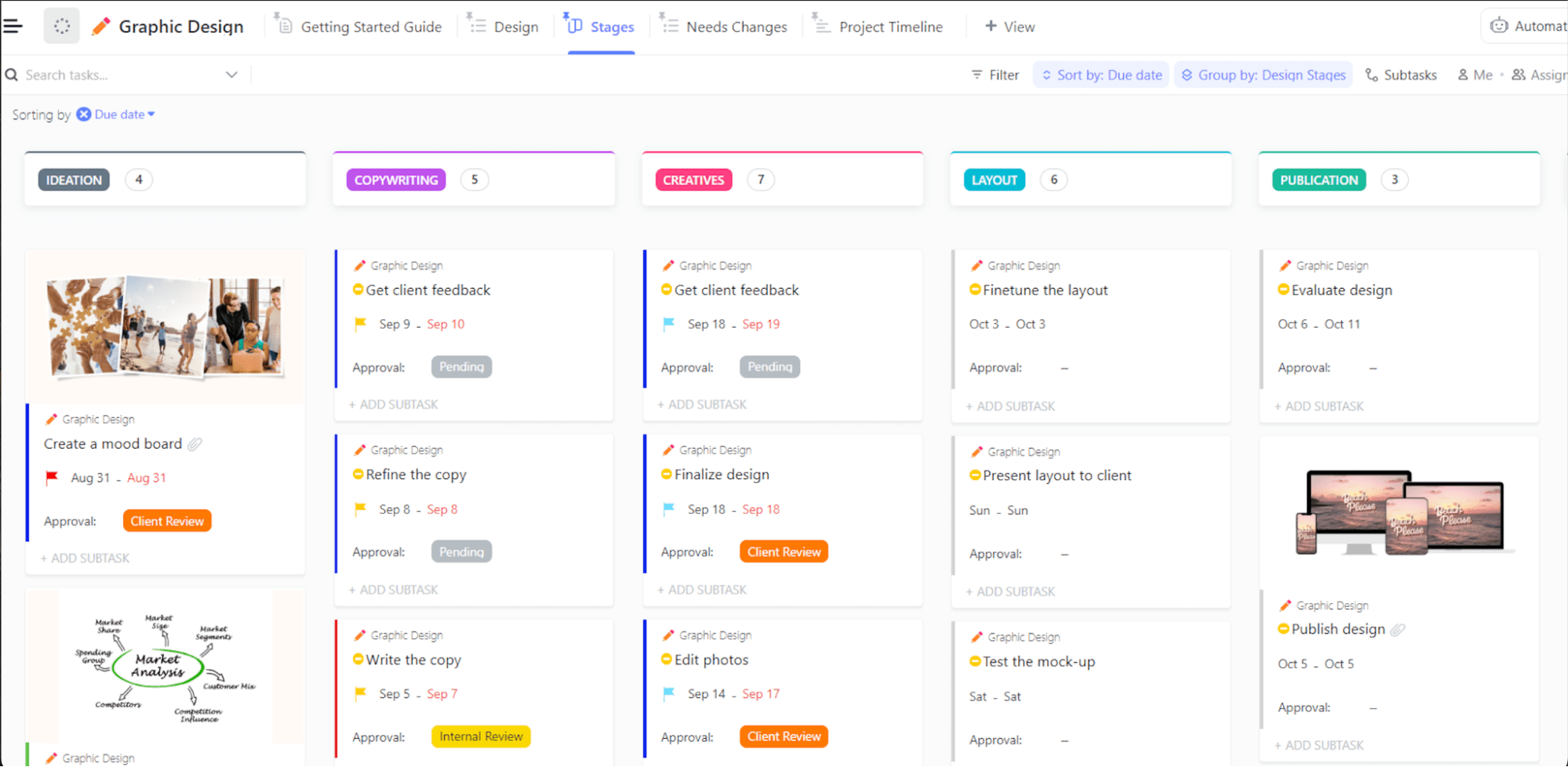
ClickUp
Although primarily a project management platform, ClickUp's whiteboard feature is a surprisingly good visual collaboration and brainstorming design tool.
ClickUp's whiteboard feature stands out because it integrates with project workflows —especially if your team already uses the ClickUp management tool. It may not replace dedicated whiteboard tools, but it’s a convenient option for basic visual collaboration and brainstorming without needing to switch platforms.
ClickUp best features:
Real-time collaboration capabilities
Task creation directly from whiteboard elements
Template-based starting points
Interactive table embedding
Infinite canvas functionality
Cross-team accessibility
ClickUp limitations:
Less robust than dedicated whiteboard tools
Basic drawing capabilities
Some interface navigation challenges
Limited advanced visualization features
Fewer customization options compared to specialized tools
ClickUp pricing:
Free: 3 whiteboards
Unlimited: $7/user/month - 10 whiteboards
Business: $12/user/month - Unlimited whiteboards
Enterprise: Custom pricing - Unlimited whiteboards with advanced features
ClickUp ratings:
G2: 4.7/5
Capterra: 4.6/5
9. Miro

Miro
Miro combines diagramming, flowcharting, mind mapping, and video conferencing capabilities into one tool. Its strength is creating an intuitive, collaborative workspace that feels like just a natural part of in-person brainstorming.
Miro is great for teams that are spread out but need a visual collaboration tool that can handle more complex design needs. But, teams with simpler needs or ones that only need text-based collaborations might find most of its features unnecessary.
Miro best features:
Real-time collaboration with video and audio capabilities
Built-in AI assistant (Miro Assist) timer and voting tools
Infinite canvas functionality
Presentation mode with frames
Screen sharing capabilities
Real-time cursor tracking
Integration with major platforms (Jira, Zoom, Teams)
Miro limitations:
Needs a stable internet connection
Complex features can overwhelm new users
Higher pricing compared to basic alternatives
Some advanced features restricted to paid tiers
Performance can lag with large boards
Miro pricing:
Free: 3 boards, basic features
Starter: $10/user/month - Unlimited boards, single workspace
Business: $20/user/month - Unlimited workspaces, advanced features
Enterprise: Custom pricing - Advanced security and admin features
Optional Miro Assist (AI features) available
Miro ratings:
G2: 4.8/5
Capterra: 4.7/5
Find a UX Designer for Hire
10. Sketch
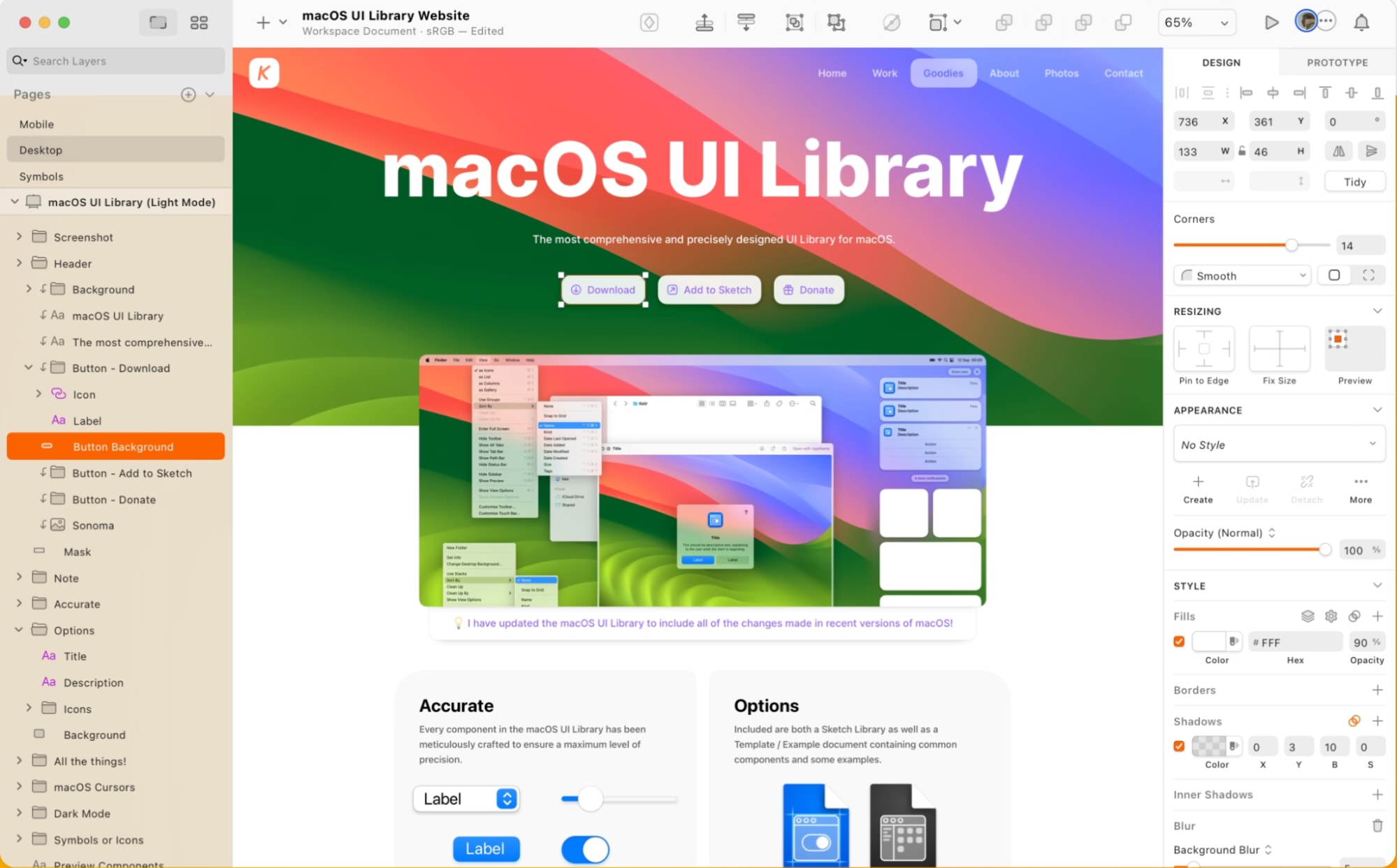
Sketch
Founded in 2010 in The Netherlands, Sketch is a vector-based design tool exclusively for macOS. The fact that it’s built only to work with macOS can make things difficult if you have a team working on other operating systems. But Sketch is known for handling complex design systems and creating efficient workflows between designers and developers.
Sketch best features:
Precise vector editing tools
Extensive compatible plugins
Real-time collaboration
CSS code export capabilities
Developer handoff tools
Sketch limitations:
macOS exclusive - no Windows or Linux support
Requires external tools for advanced prototyping
Subscription-based pricing model
Limited template library
Sketch pricing:
Standard: $10/editor/month (annual) or $12/month (monthly)
Mac-only License: $120 one-time purchase per seat
Business: $20/editor/month (annual only)
Free for students and educators
30-day trial available
Sketch ratings:
G2: 4.6/5
Capterra: 4.5/5
Hire Design Experts on Fiverr
While choosing the right design tool is crucial, having skilled designers who can maximize its potential is equally important. Fiverr connects you with experienced designers who specialize in using your chosen design tool. Whether you need help with UI/UX design, prototyping, or vector tracing, you'll find professionals ready to bring your vision to life.
Figma Alternatives FAQs
What is the best alternative for Figma?
The best alternative to Figma depends on your design needs. Adobe XD is the strongest alternative for professional teams already using Adobe products. But, Penpot is a great free choice for designers on a budget.
What is better than Figma?
It depends on your design needs. Sketch provides a more optimized experience for Mac users, while Framer is better for creating interactive designs.
What AI tool replaces Figma?
No AI tool can completely replace Figma (yet). But tools like UXPin, Framer, and Miro incorporate AI to make the design process easier and more efficient for you.
Which is better, ProtoPie or Figma?
ProtoPie and Figma solve different needs. Figma is a comprehensive design tool. ProtoPie specializes in creating interactive prototypes. Many teams use both tools together, designing in Figma and creating advanced prototypes in ProtoPie.
